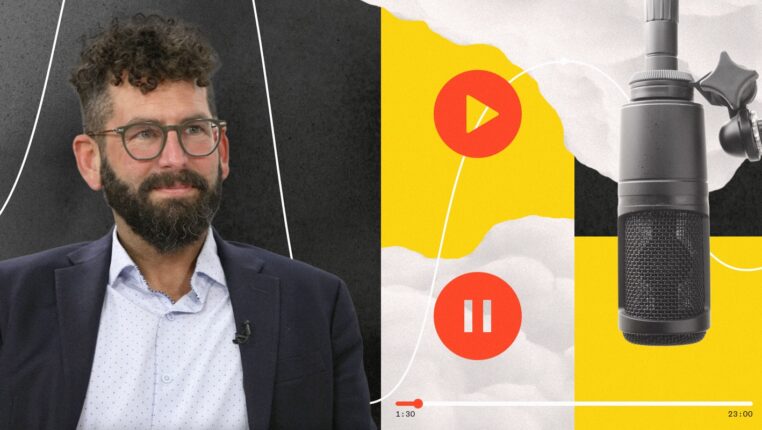I’m not sure if there’s a more obvious statement than “AI is all the rage.” At this point, if you haven’t heard about AI or played with any artificial intelligence tools, you might have just set the world record for living underwater for 100 days.
AI is everywhere, and the majority of the workforce is talking about it, tinkering with it, and incorporating it into every day tasks. You might even be burned out by the topic at this point.
Regardless of your feelings, I think we can all agree that AI is a game changer.
And, there’s no avoiding it.
It’s such a game changer you have legends like Marc Andreessen explaining how AI will save the world as Elon Musk rings the bell that AI needs regulation immediately due to its potential power.
It seems like all of this is happening at such a rapid pace. Almost everyday it’s like a new AI company raises a round of funding or some wild new use case is shared with the world.
All of this can seem daunting, but there are also immediate benefits.
Here at Electric Kite, we’re starting to see some real positive impacts within our services, and it’s already influencing our approach to PPC keyword research.
For the past few months our team has tinkered with AI and how to incorporate that into our keyword research process. If I had to guess, we’re in like the 1st or 2nd inning of this nine-inning game.
At this stage of the game, I think we’ve compiled a really solid keyword research process that incorporate AI to ensure we’re bidding on the most relevant keywords possible.
Here’s our process into paid keyword research and how we’re utilizing AI and Google’s machine learning technology. We’ll use Headspace as our example client (note: Headspace is not an actual client of ours):
1. Keyword Planning with Google’s Keyword Planner Tool
We start by using Google’s keyword planner tool which scrapes the website’s landing page you’d like to direct paid traffic toward.
Google’s keyword planner tool can provide keyword recommendations by utilizing its machine learning that has been trained on search models for years.
If Google owns the search engine real estate, I think it’s safe to say their machine learning is going to surface some relevant keywords on your behalf.
It might go without saying, but we would always recommend at the start of your paid keyword research to simply comb through the website and start compiling a list of keywords so you can accurately assess the work the AI engines will generate.
I like to have two browser windows open – one with the website I’m researching and the other with a blank spreadsheet simply jotting down as many relevant keywords that come to mind. This is typically a solid foundation to start to familiarize yourself with website, services and potential keywords to bid on.
Now, with Google’s keyword planner, there’s two ways you could utilize the ‘Discover new keywords’ option:
- You could provide Google with 10 initial keywords you found AND their website
- You could provide Google with just the website
Either way, Google is going to provide you with keyword ideas:
After you select “Get results” you’ll then be provided with some keyword recommendations:
With that excel sheet, I’ll start compiling as many keywords as possible from my initial website comb and then from the list of ideas that Google provides.
Not all of these keywords will be viable options for paid campaigns, so you’ll need to analyze Google’s recommendations carefully and consider your client’s goals.
2. Prompt ChatGPT for More Keywords
Next, we use ChatGPT Plus to find more keywords. For this example I’m going to be using the actual ChatGPT interface, but I’ve also put together a two-minute video guide on how to integrate chat functionality directly into your Google Sheets. All the prompts we’re going to use in this example can be applied directly to Google Sheets as well.
The cool thing I’ve found with prompting ChatGPT is that you get better at it over time. You begin to learn the nuances of wording certain things and really how to get the most out of the machine.
I’d also consider compiling a workbook that you share with teammates on the best prompts that got you the best responses you were looking for. It’ll make your life easier when you can copy and paste top prompts you’ve utilized.
Here’s a prime example of how we can turn ChatGPT into a PPC manager:
Prompt
“You’re a Google Ads manager and your client is “Headspace” the meditation app. Please provide an extensive list of all the keywords you would recommend bidding on in Google Ad keyword auctions. Please reference their website for this research: https://www.headspace.com/”
This initial prompt got me about 50 keyword ideas.
Of course, not all of the keyword recommendations are going to be relevant or worth bidding on. That’s where your personal strategy and experience comes into play. You need to apply your human filter here and use your best judgment of which keywords are worth bidding on vs which keywords would be too broad. AI is a tool that’s going to help with ideas and productivity, but at the end of the day there’s still going to need a human filter to determine the appropriate keywords.
And generally speaking I’ll prompt ChatGPT about five to seven times or so when conducting this initial set of keyword research. I’ll usually asks things like “now please provide more keywords but include variations with ‘for download’” or some variation that I’ve identified the machine missed or just a hunch I might have from experience. You might also want to consider prompting for things like competitor or branded campaigns and see what ideas are surfaced.
After going through this filtration process for about five to seven rounds, you’re going to have a really solid list of keywords. I’d recommend writing down as many as you can in that spreadsheet.
I’d also recommend you tinkering with some of the plugins that integrate with ChatGPT. That’s an entire topic for another blog and you can go down some serious rabbit holes with potential use cases there.
3. Rinse and Repeat with Bard
Next, we repeat the above step, swapping in Bard for ChatGPT.
I’d highly recommend using both Bard and ChatGPT in this process and comparing results over time because. That’s because it’s tough to say at this point which provides better results, so A/B testing your prompts is a good safeguard and learning exercise for the foreseeable future.
Here’s an example response from Bard specifically for long-tail keyword variations:
As stated, it’s going to take some testing with prompts to get to solid recommendations. In the Bard example the first results of keywords I got were really broad like the word “meditation” and after some prompts you’re going to get better results.
And the nice thing is the speed of these chat interfaces. Whether you’re using Bard or ChatGPT they both provide results in seconds, which makes the process really easy and fast.
4. Get Some Competitor Keywords
It’s always great to incorporate some competitors into the mix to inform your keywords.
In this Headspace example I think it would be worth checking out the paid and organic keywords from Calm and other meditation apps.
And I would recommend repeating steps 1-3 but using the competitor’s websites and comparing those keywords to the ones already on your list. It’s really interesting to see what different keywords are identified by simplifying changing the URL you provide.
Additionally, I like to use some competitor research tools to inform my keyword recommendations.
I’ll usually utilize SimilarWeb to take a look at my competitor’s keywords. You can simply place their URL into the tool and then analyze their paid and organic keywords.
There’s a bunch of these competitor tools on the market that are worth testing and incorporating into your process.
5. Other Quick Wins
Here are a few other quick wins I’d look to implement after you’ve completed the first 4 steps:
- Start Googling some of your top keywords and take a look at the ‘People Also Ask’ section. Google is going to provide you with keyword variations of related searches based on your query. I usually find some gold there.
- Once you have as extensive a list as possible, place the top 10 keywords back into Google’s keyword idea planner for another pass. Do the same thing to ChatGPT & Bard and see what they think of your top keywords.
Done. You have an extensive list. I hope.
The next part is strategically thinking about campaign structure, match types, cascading negatives, which smart bidding method to use, which audiences to target and all that good stuff.
But, at least you now have a list of keywords you can be confident with.
It’s worth mentioning you could do a similar process for ad copywriting, but that’s a topic for another blog.
If you have any questions about this post, or my keyword process, or even have feedback please do not hesitate to reach out.



